Ransom.MSIL.SYRK.A
Trojan-Ransom.Win32.Gen.sdl (Kaspersky)
Windows


Threat Type: Ransomware
Destructiveness: No
Encrypted: No
In the wild: Yes
OVERVIEW
Downloaded from the Internet, Dropped by other malware
This Ransomware arrives on a system as a file dropped by other malware or as a file downloaded unknowingly by users when visiting malicious sites.
It encrypts files with specific file extensions. It encrypts files found in specific folders. It drops files as ransom note.
TECHNICAL DETAILS
12,849,152 bytes
EXE
No
29 Jul 2019
Drops files, Terminates processes, Displays message/message boxes, Connects to URLs/IPs
Arrival Details
This Ransomware arrives on a system as a file dropped by other malware or as a file downloaded unknowingly by users when visiting malicious sites.
Installation
This Ransomware drops the following files:
- C:\Users\Default\AppData\Local\Microsoft\-pw+.txt -> contains password
- C:\Users\Default\AppData\Local\Microsoft\+dp-.txt -> contains password and victim ID
- C:\Users\Default\AppData\Local\Microsoft\-i+.txt -> contains victim ID
It drops and executes the following files:
- C:\Users\Public\Documents\cgo46ea565sdfse7.exe -> detected as Ransom.Win32.SYRK.A
- used by the malware to search and encrypt files by executing a Powershell script
- C:\Users\Public\Documents\dh35s3h8d69s3b1k.exe -> detected as Trojan.Win32.SYRK.A
- used in decrypting files, also uses a Powershell script
- C:\Users\Public\Documents\startSF.exe -> detected as Trojan.Win32.SYRK.A
- used to move C:\Users\Public\Documents\SydneyFortniteHacks.exe to %User Startup%\SydneyFortniteHacks.exe
- C:\Users\Public\Documents\DeleteFile.exe -> detected as Trojan.Win32.SYRK.A
- used to delete files this malware created
- C:\Users\Public\Documents\delmy.exe -> detected as Trojan.Win32.SYRK.A
- used to delete the file: %User Startup%\SydneyFortniteHacks.exe
- C:\Users\Public\Documents\LimeUSB_Csharp.exe -> detected as Worm.MSIL.LIME.AA
Autostart Technique
This Ransomware drops the following file(s) in the Windows User Startup folder to enable its automatic execution at every system startup:
- %User Startup%\SydneyFortniteHacks.exe
(Note: %User Startup% is the current user's Startup folder, which is usually C:\Windows\Profiles\{user name}\Start Menu\Programs\Startup on Windows 98 and ME, C:\WINNT\Profiles\{user name}\Start Menu\Programs\Startup on Windows NT, C:\Documents and Settings\{User name}\Start Menu\Programs\Startup on Windows 2003(32-bit), XP and 2000(32-bit), or C:\Users\{user name}\AppData\Roaming\Microsoft\Windows\Start Menu\Programs\Startup on Windows Vista, 7, 8, 8.1, 2008(64-bit), 2012(64-bit), 10(64-bit).)
Other System Modifications
This Ransomware modifies the following registry entries:
HKEY_LOCAL_MACHINE\SOFTWARE\Policies\
Microsoft\Windows Defender
DisableAntiSpyware = 0
(Note: The default value data of the said registry entry is {User Preference}.)
HKEY_LOCAL_MACHINE\SOFTWARE\Microsoft\
Windows\CurrentVersion\Policies\
System
EnableLUA = 0
(Note: The default value data of the said registry entry is {User Preference}.)
HKEY_CURRENT_USER\Control Panel\Desktop
WallpaperStyle = 1
(Note: The default value data of the said registry entry is {User Preference}.)
HKEY_CURRENT_USER\Control Panel\Desktop
TileWallpaper = 0
(Note: The default value data of the said registry entry is {User Preference}.)
It sets the system's desktop wallpaper to the following image:
- C:\51875.jpg
Process Termination
This Ransomware terminates the following processes if found running in the affected system's memory:
- Taskmgr
- Procmon64
- ProcessHacker
Other Details
This Ransomware displays the following images:
- Main display:
- "Show My ID" button:
- If password input is correct and "Decrypt my Files" button is clicked:
It does the following:
- If the timer in the main display times out, it will delete files with .Syrk extension in the following directories:
- %User Profile%\Desktop
- %User Profile%\Document
- %User Profile%\Pictures
- It pings the following URL:
- {BLOCKED}94fg5sb3y8l.{BLOCKED}hostapp.com
- On execution, it will move {current directory}\SydneyFortniteHacks.exe to C:\Users\Public\Documents\SydneyFortniteHacks.exe
- It sends the following via SMTP:
- Content:
- Attachment: C:\Users\Default\AppData\Local\Microsoft\+dp-.txt
- Subject: ID&Pass
- To:
- Host: {BLOCKED}mail.com
- Email: {BLOCKED}som@gmail.com
- Content:
- It has a built in decryptor but it will only work if the input password is correct.
Ransomware Routine
This Ransomware encrypts files with the following extensions:
- gif
- sln
- docx
- php
- psd
- ico
- mov
- xlsx
- jpg
- xls
- doc
- wav
- pptx
- ppt
- txt
- png
- bmp
- rar
- zip
- mp3
- mp4
- avi
It encrypts files found in the following folders:
- %User Profile%
(Note: %User Profile% is the current user's profile folder, which is usually C:\Documents and Settings\{user name} on Windows 2000(32-bit), XP, and Server 2003(32-bit), or C:\Users\{user name} on Windows Vista, 7, 8, 8.1, 2008(64-bit), 2012(64-bit) and 10(64-bit).)
It appends the following extension to the file name of the encrypted files:
- .Syrk
It drops the following file(s) as ransom note:
- %Desktop%\Readme_now.txt
(Note: %Desktop% is the current user's desktop, which is usually C:\Documents and Settings\{User Name}\Desktop on Windows 2000(32-bit), XP, and Server 2003(32-bit), or C:\Users\{user name}\Desktop on Windows Vista, 7, 8, 8.1, 2008(64-bit), 2012(64-bit) and 10(64-bit).)
It leaves text files that serve as ransom notes containing the following text:
SOLUTION
9.850
15.272.06
02 Aug 2019
15.273.00
03 Aug 2019
Step 1
Before doing any scans, Windows 7, Windows 8, Windows 8.1, and Windows 10 users must disable System Restore to allow full scanning of their computers.
Step 2
Note that not all files, folders, and registry keys and entries are installed on your computer during this malware's/spyware's/grayware's execution. This may be due to incomplete installation or other operating system conditions. If you do not find the same files/folders/registry information, please proceed to the next step.
Step 3
Restart in Safe Mode
Step 4
Search and delete this file
- %User Startup%\SydneyFortniteHacks.exe
- C:\Users\Public\Documents\cgo46ea565sdfse7.exe
- C:\Users\Public\Documents\dh35s3h8d69s3b1k.exe
- C:\Users\Public\Documents\startSF.exe
- C:\Users\Public\Documents\DeleteFile.exe
- C:\Users\Public\Documents\delmy.exe
- C:\Users\Public\Documents\LimeUSB_Csharp.exe
- C:\Users\Public\Documents\SydneyFortniteHacks.exe
- C:\Users\Default\AppData\Local\Microsoft\-pw+.txt
- C:\Users\Default\AppData\Local\Microsoft\+dp-.txt
- C:\Users\Default\AppData\Local\Microsoft\-i+.txt
Step 5
Restore this modified registry value
Important: Editing the Windows Registry incorrectly can lead to irreversible system malfunction. Please do this step only if you know how or you can ask assistance from your system administrator. Else, check this Microsoft article first before modifying your computer's registry.
- In HKEY_LOCAL_MACHINE\SOFTWARE\Policies\Microsoft\Windows Defender
- DisableAntiSpyware = 0
- DisableAntiSpyware = 0
- In HKEY_LOCAL_MACHINE\SOFTWARE\Microsoft\Windows\CurrentVersion\Policies\System
- EnableLUA = 0
- EnableLUA = 0
- In HKEY_CURRENT_USER\Control Panel\Desktop
- WallpaperStyle = 1
- WallpaperStyle = 1
- In HKEY_CURRENT_USER\Control Panel\Desktop
- TileWallpaper = 0
- TileWallpaper = 0
Step 6
Restart in normal mode and scan your computer with your Trend Micro product for files detected as Ransom.MSIL.SYRK.A. If the detected files have already been cleaned, deleted, or quarantined by your Trend Micro product, no further step is required. You may opt to simply delete the quarantined files. Please check this Knowledge Base page for more information.
Step 7
Reset your Desktop properties
Step 8
Restore encrypted files from backup.
Did this description help? Tell us how we did.





